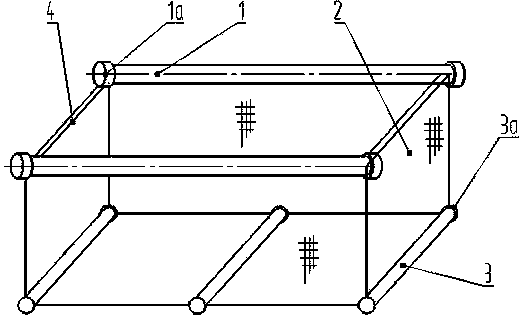Method of cultivating fry of Apostichopus japonicus by floating cages in ponds
A cultivation method and a suspension type technology are applied in the field of cultivating Apostichopus japonicus seedlings in suspended cages in ponds, which can solve the problems of high density of seedlings, pollute the environment, energy consumption of artificial seedlings, etc., prolong the growth period, improve the survival rate, and facilitate popularization. Effect
- Summary
- Abstract
- Description
- Claims
- Application Information
AI Technical Summary
Problems solved by technology
Method used
Image
Examples
Embodiment Construction
[0022] 1. Cage production and placement
[0023] Cage specifications: length, width and height are 4m×2m×1.2 m, made of 20-mesh silk screen;
[0024] Cage frame: Long side 1 uses plastic pipes (polyethylene or polyvinyl chloride pipe Φ60mm), both ends of which are screwed tightly with nuts 1a to seal it and can float on the water; wide side 4 uses bamboo poles or wooden poles Connect with long side 1 to form a rectangular frame. Three plastic pipes 3 (polyethylene or polyvinyl chloride pipe Φ40mm) with the same length as the wide side are used at the bottom of the net cage 2, and coarse sand or heavy objects are contained inside, and the two ends are tightly screwed with nuts 3a to seal them, and are connected to the net. The bottom of the case 2 is connected, one at both ends and one in the middle, so that the net cage 2 sinks and opens.
[0025] Cage placement: After the cages are made, put them in the pond, arrange them in rows, tie the wide sides with long ropes, a...
PUM
 Login to View More
Login to View More Abstract
Description
Claims
Application Information
 Login to View More
Login to View More - R&D
- Intellectual Property
- Life Sciences
- Materials
- Tech Scout
- Unparalleled Data Quality
- Higher Quality Content
- 60% Fewer Hallucinations
Browse by: Latest US Patents, China's latest patents, Technical Efficacy Thesaurus, Application Domain, Technology Topic, Popular Technical Reports.
© 2025 PatSnap. All rights reserved.Legal|Privacy policy|Modern Slavery Act Transparency Statement|Sitemap|About US| Contact US: help@patsnap.com


